The relationship between horizontal hemisphere and bottom cup depth, and how to maintain balance as you move the apex
Using different sizes for the bottom cup depth and horizontal hemisphere
(BCD and HH) of your bra cups has become a popular alteration, with
some pattern makers going as far as to suggest making these changes
before sewing up a single bra, instead considering it as part of an
overall sizing system.
A little while ago, I asked my Instagram followers what these alterations do - but there was no consensus in the response.
asked my Instagram followers what they thought these alterations actually did, with no consensus in the response.
This surprised me a little - people seem to make these alterations a lot, but it seems that the expected results aren't clear, let alone if the actual results match the expected results.
So let's find out what happens when we make alterations to these dimensions in our bras. Hopefully, by the end of this post, you will see why I have come to believe that separate BCD and HH sizing is a bad idea and leads people to more confusion and poorer fits.
An extended version of this post is available on my Ko-Fi. You can read this and all of my other extended posts for a donation of just £2/$3, and you can subscribe to continue supporting my blog, and to get extended editions of posts into the future.
The Experiment
My favourite bra pattern is one that I have directly copied from my best fitting ready to wear bra - the Cleo Marcie in 28GG. It fits slightly small on my larger breast, and well on my smaller breast. I took the base pattern and made some alterations, using the standard method of changing the cup radius at the wireline.
0 - Control bra with no alterations
1- Reduced BCD, Increased HH. I reduced the BCD by two sizes (12mm total) and increased the HH by 6mm on both the inner and outer cups. This is to maintain a similar overall cup volume, as I know the volume of the bra fits well.
2 - Increased BCD, Reduced HH. I increased the BCD by two sizes and decreased the HH accordingly.
Expected Results:
From what I can tell, the conventional wisdom is that the HH controls the projection of the bra, and the BCD the apex height. So for Bra 1, you would expect to see a lower apex and more projected bra, and for Bra 2, a higher apex and less projection.
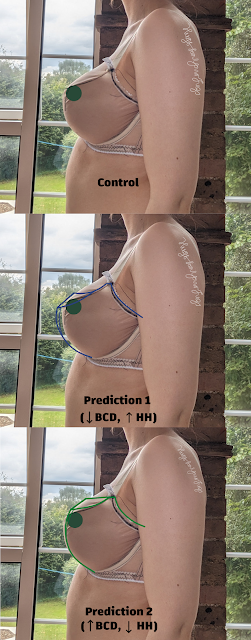 | ||
The Results:
Cup 1 - Increased HH, reduced BCD
Comparing the result to the outlined prediction, we can see that the bra hasn't behaved as expected. There is no increase in projection, and a surprisingly substantial lowering of the apex. See the dotted grey line which indicates the original apex position for comparison.
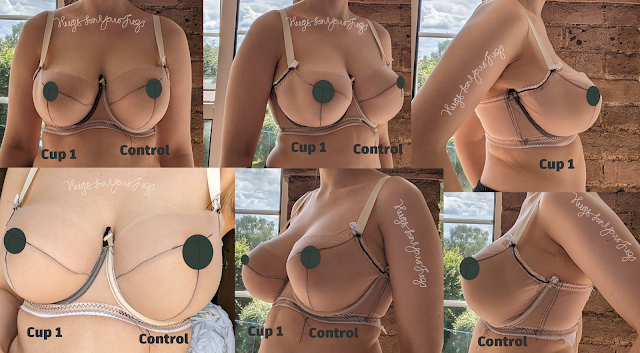 |
- The diagonal cup seam is now wavy near the gore
- There is a noticeable dent in the side cup, and some of the side cup is bagging out
- The bra feels as though there is more weight on my shoulder and is overall less comfortable
- Coverage on the upper breast has been reduced/the strap has been lowered
- The whole bra has a downwards-tilted appearance in comparison to the control.
Cup 2 - Increased BCD, reduced HH
We expected to see a higher apex and reduced overall projection, but again this hasn't happened. The projection has reduced, but the apex has remained in place.
 |
In addition, we can observe the following changes:
- There is less support overall, the lower cup now sits below the wire
- The cup shape has become squareish
- There are wrinkles in the lower cup
So what's going on? Why has one of the expected changes, but not the other, happened - but a different one each time?
Horizontal Hemisphere and Cup Projection
Many people consider the horizontal hemisphere to be the determinant of projection in a bra. Unfortunately, it is not that simple. Here's a quick illustration of why:
 |
You can see that to go from the left cup to the middle, both the BCD and the HH of the bra need to be increased. The cup radius needs to be increased everywhere to increase the projection (while maintaining the same wireline length). This is the same as going up in cup volume and decreasing the overall wireline.
 |
Excess HH may cause wrinkles and extra space but sometimes just causes bulging in the sides of the cup, rather than any wrinkles and extra space - the cup rotation can hide where that extra volume is.
Note that the HH increase alone does increase projection slightly, but this always comes with a lowered apex. This is because of the interaction between these two fixed lengths.
If we just decrease HH, the corresponding BCD has nowhere to go, so bulges out at the bottom.
BCD and Apex Height
A fabric-cupped bra works entirely in tension. That is, the upper cup is suspended from the strap and wire tips, and the lower cup is suspended from the upper cup.
If
the upper cup does not change despite increased length to the lower
cup, it's not going to sit any higher - it's still suspended from the
same point. Therefore, an increased BCD just causes extra material to sit at the bottom of the cup. If the BCD was originally too short, the apex may rise, but after it "balances out" with the HH, no further lift can occur.
A decreased BCD pulls the apex downwards, as it is now comparatively too short for the HH.
What Happened to Bra 1
What Happened to Bra 2
The Relationship between HH and BCD
Something that I really want to stress here is that, if you want your HH to remain horizontal, and the lower cup to maintain a nice shape, the HH and BCD in a bra are in a fixed ratio: these are not separate values that change based on personal measurements. This ratio depends on the wire positioning on the body, the shape of the wire, the position of the seams, and the intended shaping and curvature of the cups.
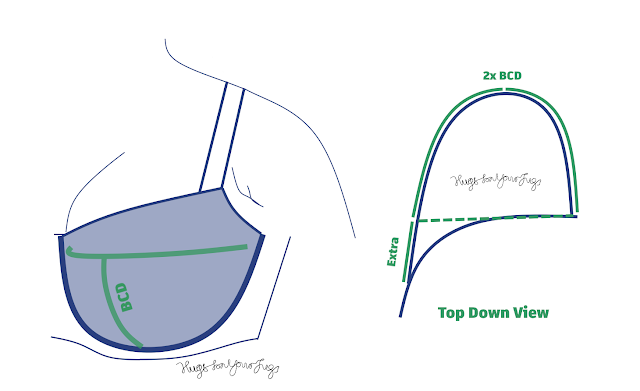 |
In very very oversimplified terms, and imagining a cup with a circular wire shape, an HH line halfway up that circle, and even curvature for the inside, outside, and bottom cup, the HH = 2*BCD + side coverage.
Now obviously there are about a thousand different factors that can influence these two seam lengths, so it's absolutely not a strict guide, but I really want to get across the idea of the BCD and HH working together to produce projection, and their relationship coming back to how your wire curves around your frame.
If your bra deviates significantly from this ratio and you're having some problems with the fit, this might be something to look at.
If you find that your nipples sit below or above the intended apex - first consider if the volume itself is wrong for you. It can be easy to get stuck in a bra that's overall too large, struggling to get more lift out of it.
What do I do if I need a lower or higher apex?
If you need to lower the apex, the upper cup needs to be adjusted too to avoid wrinkles/pulling/tilting in the bra. These alterations work for moving the apex up too, they just need to be done in reverse.
Alternatively, you can just move the apex down by adding to the upper cup what was removed from the BCD, intentionally tilting your seam downwards but not making it drop an unexpected amount.
Another potential option is to increase fullness in the lower cup seam - effectively increasing the cup radius lower down. The upper cup's radius is then decreased to maintain volume. This one is a little tricky to get right, so I don't really recommend it, but the apex does not have to be at the intersection of seams.
If the apex itself sits too low, the upper cup needs to be adjusted to suspend the apex from a higher point, by removing from the upper cup and adding to the BCD. You may also want to consider moving the seam upwards as well.
Typically, those with full on top breasts need a higher apex than those with full on bottom breasts - the shorter upper cup piece conforms better to a rounded upper breast shape, rather than a larger one which can flatten out and cut in - so this might be some help to determine if you need a higher apex or a larger cup overall.
A note on nipple position
You can see that my nipples are
aligned at the apex on all of these bras. This is because the fullest
part of my breast naturally falls towards the fullest part of the cups,
even if the rest does not fit well.
In the extended version, I talk about how curvature - and differing curvature in different regions of the bra - impacts this HH and BCD relationship. You can access this version by donating to my Ko-Fi.



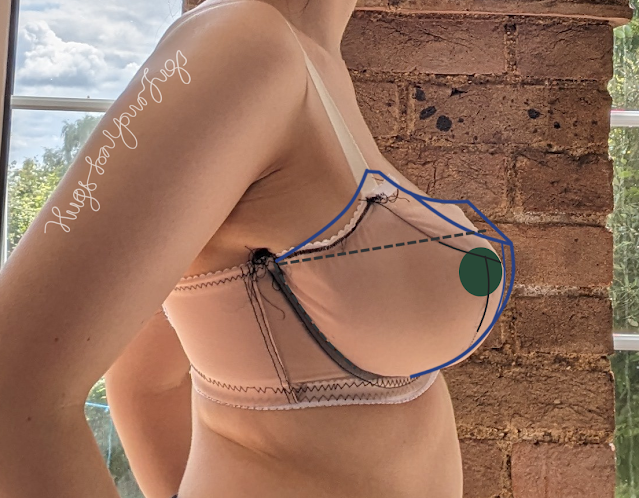


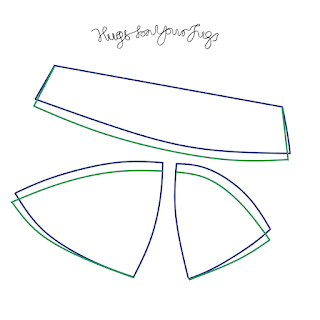
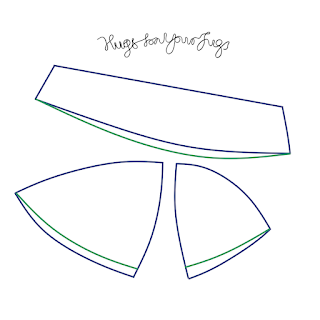

Thanks, this explanation is well made and clear. I appreciate the effort and time taken to inform and enlighten
ReplyDeleteI always appreciate your efforts to examine an issue scientifically, and to test your theories. But in this case I think you're going a bit off base by testing these changes on the same pair of breasts. Now I agree that many people pick alterations according to the latest thing they read rather than anything rational. But you're overlooking the fact that many of us just have different proportions than what patternmakers expect. Different even than what's being taught at the few schools that address lingerie. You're starting from a bra that fits you, so pretty much any change you make is going to give you less than optimal results. These experiments could well be helpful in guiding custom patternmakers to better diagnosis of fit problems. But as someone afflicted with a 3 size gap between bcd and hh, I assure you that correcting for that is neither random nor negative in the results. The millions of women with neglected proportions can benefit from correcting them to fit themselves (and of course we're overrepresented in groups trying to refine fit)
ReplyDeleteHi,
DeleteThank you for your coment. I feel like there are some misconceptions about my methods that I want to clear up. While I did frame this post as a "let's test out this theory" kind of post, I started using these ideas with my fitting clients with success before I decided to write the post. The bra I made is a formal test and more of a confirmation of what I already knew.
While I agree that changing a well fitting bra is going to make the fit worse, the fact is that the fit did not change in the way suggested by conventional wisdom.
I'm glad that you have found the bcd reduction successful, however I cannot imagine a breast shape that would be better served by a bcd reduction than by an intentional apex move, or by a cup size down (or some combination of the two). Yes, breast shapes vary considerably, but the upper cup is always going to want to support an apex that is higher than the bottom cup's apex wants to meet it, so geometrically there's a conflict there.
Your suggestion that I believe the results are random suggests that perhaps you wrote this comment without reading the post fully, I ask that you perhaps try and reserve your judgment and give it another go.
As someone with zero knowledge of bra alterations and just a vague understanding of breast shapes, I'm curious to know how this all fits in with the idea of immediate projection. Is this an alteration that would make sense if youre very FOB or for other reasons might need more projection at the wire but not a deeper overall cup?
ReplyDeleteI'm struggling a bit to visualise how for instance having a wide root can also go with being projected (and, as someone who prefers to have data analysis make choices for me, how those consepts can be translated to numbers and concrete things to look for in Bratabase 😉). Is the relationship between BCD and HH the key here?
Hi, only just saw this comment, sorry.
DeleteImmediate projection is not really a term I use much in my fitting as I find it is very often cited as the cause for any issue with the lower cup. So without being to actually look at your individual fit I can't really say what would be right for you.
Wide roots and projection - I don't really believe that this is a "thing" to be honest, it's more an idea that other people talk about. To me, projection is an issue of cup volume vs wire size, wire size being a combination of root width and height. So having wide roots would preclude someone from being very projected unless perhaps they needed an unusually short wire alongside that.
Hope this helps!